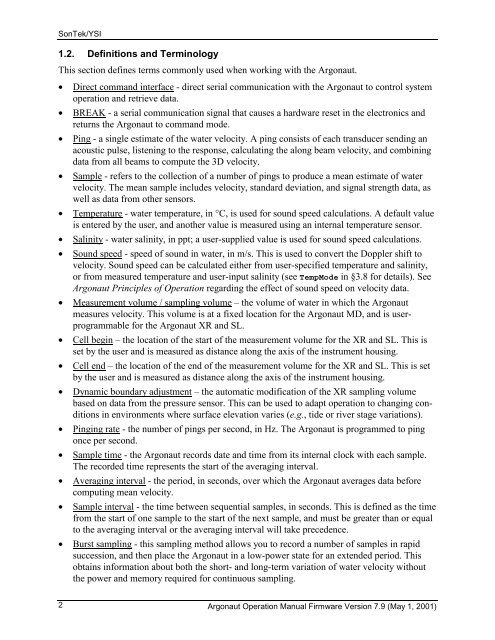SonTek/YSI Argonaut-XR Technical Manual - HydroScientific West
SonTek/YSI Argonaut-XR Technical Manual - HydroScientific West
SonTek/YSI Argonaut-XR Technical Manual - HydroScientific West
Create successful ePaper yourself
Turn your PDF publications into a flip-book with our unique Google optimized e-Paper software.
<strong>SonTek</strong>/<strong>YSI</strong><br />
1.2. Definitions and Terminology<br />
This section defines terms commonly used when working with the <strong>Argonaut</strong>.<br />
• Direct command interface - direct serial communication with the <strong>Argonaut</strong> to control system<br />
operation and retrieve data.<br />
• BREAK - a serial communication signal that causes a hardware reset in the electronics and<br />
returns the <strong>Argonaut</strong> to command mode.<br />
• Ping - a single estimate of the water velocity. A ping consists of each transducer sending an<br />
acoustic pulse, listening to the response, calculating the along beam velocity, and combining<br />
data from all beams to compute the 3D velocity.<br />
• Sample - refers to the collection of a number of pings to produce a mean estimate of water<br />
velocity. The mean sample includes velocity, standard deviation, and signal strength data, as<br />
well as data from other sensors.<br />
• Temperature - water temperature, in °C, is used for sound speed calculations. A default value<br />
is entered by the user, and another value is measured using an internal temperature sensor.<br />
• Salinity - water salinity, in ppt; a user-supplied value is used for sound speed calculations.<br />
• Sound speed - speed of sound in water, in m/s. This is used to convert the Doppler shift to<br />
velocity. Sound speed can be calculated either from user-specified temperature and salinity,<br />
or from measured temperature and user-input salinity (see TempMode in §3.8 for details). See<br />
<strong>Argonaut</strong> Principles of Operation regarding the effect of sound speed on velocity data.<br />
• Measurement volume / sampling volume – the volume of water in which the <strong>Argonaut</strong><br />
measures velocity. This volume is at a fixed location for the <strong>Argonaut</strong> MD, and is userprogrammable<br />
for the <strong>Argonaut</strong> <strong>XR</strong> and SL.<br />
• Cell begin – the location of the start of the measurement volume for the <strong>XR</strong> and SL. This is<br />
set by the user and is measured as distance along the axis of the instrument housing.<br />
• Cell end – the location of the end of the measurement volume for the <strong>XR</strong> and SL. This is set<br />
by the user and is measured as distance along the axis of the instrument housing.<br />
• Dynamic boundary adjustment – the automatic modification of the <strong>XR</strong> sampling volume<br />
based on data from the pressure sensor. This can be used to adapt operation to changing conditions<br />
in environments where surface elevation varies (e.g., tide or river stage variations).<br />
• Pinging rate - the number of pings per second, in Hz. The <strong>Argonaut</strong> is programmed to ping<br />
once per second.<br />
• Sample time - the <strong>Argonaut</strong> records date and time from its internal clock with each sample.<br />
The recorded time represents the start of the averaging interval.<br />
• Averaging interval - the period, in seconds, over which the <strong>Argonaut</strong> averages data before<br />
computing mean velocity.<br />
• Sample interval - the time between sequential samples, in seconds. This is defined as the time<br />
from the start of one sample to the start of the next sample, and must be greater than or equal<br />
to the averaging interval or the averaging interval will take precedence.<br />
• Burst sampling - this sampling method allows you to record a number of samples in rapid<br />
succession, and then place the <strong>Argonaut</strong> in a low-power state for an extended period. This<br />
obtains information about both the short- and long-term variation of water velocity without<br />
the power and memory required for continuous sampling.<br />
2<br />
<strong>Argonaut</strong> Operation <strong>Manual</strong> Firmware Version 7.9 (May 1, 2001)


